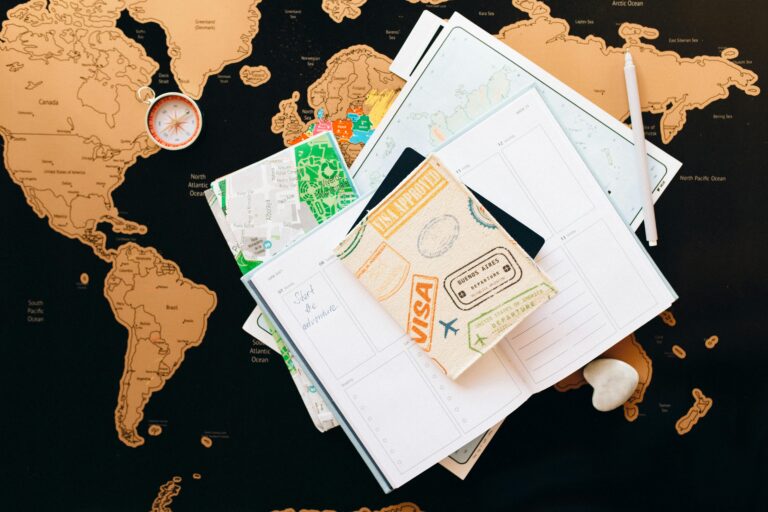Best Countries for Digital Nomads — Where to Live, Work, and Thrive in 2025
✨ Summary
The best countries for digital nomads in 2025 balance visa security, affordability, safety, and strong communities. Portugal and Spain lead for EU access and long-term stability, while Thailand, Bali, and Mexico attract budget-conscious nomads with thriving hubs. Costa Rica offers eco-living with reliable infrastructure. Choosing the right base depends on your income, career goals, and lifestyle priorities — supported by tools like FlexJobs, Remote Rocketship, Mondly, and NordVPN.
Contents: What You’ll Learn
Digital nomadism isn’t a fringe lifestyle anymore—it’s a global movement. As work freed itself from the office, countries worldwide began competing for location-independent professionals by launching digital nomad visas, offering tax perks, and building remote-friendly infrastructure.
In this three-part series, we’ll explore the top countries where remote workers can live comfortably while meeting visa requirements, minimizing costs, and maximizing lifestyle. This first chapter breaks down the criteria that matter most, and introduces standout destinations emerging in 2025.
🚀 FlexJobs Subscription
Curated remote job board with premium listings.
30% off for RWC readers – $29.95.
Get This Deal
🚀 Avast Premium Security
Security suite to keep your remote work devices protected.
Save up to 40% today – $39.99.
Get This Deal
🚀 NordVPN Subscription
VPN for secure remote work connections and privacy.
Up to 63% off annual plans – $59.88.
Get This Deal
What Makes a Country “Best” for Digital Nomads?
Not all sunny beaches or low-cost cities make great long-term nomad hubs. The most successful destinations tick several key boxes:
- Visa Accessibility & Duration
Long-term or multi-year digital nomad visas like Barbados’ Welcome Stamp or Estonia’s e-Residency Nomad Visa provide legal stability. - Cost of Living vs Earning Power
Nomads need budgeting clarity. For example, Chiang Mai (Thailand) has an average cost of $1,000/month, but nomads there often earn from U.S. or European remote tech jobs. - Digital Infrastructure & Stability
Fast, reliable internet and co-working ecosystems are essential. Berlin, Germany, for instance, consistently ranks in tests for urban connectivity. - Safety, Healthcare & Culture
A strong healthcare system and welcoming environment greatly enhance experience—Portugal and Canada consistently score high in global safety indexes. - Community & Networking
Loneliness is a frequent challenge. Cities like Medellín, Colombia offer vibrant nomad hubs with meetups, shared workspaces, and expat networks.
Spotlight Destinations: Nomad-Friendly Leaders in 2025
1. Portugal (Lisbon & Porto)
Portugal remains a top pick due to its D7 Visa and new Digital Nomad Visa (D8) that allow stays up to five years. Lisbon, Porto, and the Madeira Digital Nomad Village boast quality infrastructure, affordable Europe-level salaries, and community events. The D7 Visa is accessible to remote workers with qualifying income.Source: SEF Portugal – D7 and D8 Visas
2. Germany (Berlin)
Berlin’s Startup Visa (which can be adapted for remote freelancers via freelance visas) grants up to three years of residency, strong healthcare systems, and centralized connectivity. Reliable internet and a major English-speaking creative community make it a European standout.
3. Thailand (Chiang Mai & Phuket)
Thailand introduced a Smart Visa, extended for digital professionals, entrepreneurs, and investors. Combined with low-cost living, warm weather, and nomad infrastructure (like coworking cafés in Chiang Mai), Thailand continues to dominate the nomad scene.
4. Estonia
As a pioneer of digital nomad policy, Estonia offers a Nomad Visa allowing stays up to a year, and e-Residency to simplify digital business operations. With high-speed Wi-Fi and e-government systems, it’s an attractive base for location-independent entrepreneurs.Source: Estonia Nomad Visa Information
5. Mexico (Playa del Carmen & Mexico City)
Mexico’s Temporary Resident Visa allows remote work for up to four years. Cities like Playa del Carmen and Mexico City provide low living costs, vibrant culture, and solid infrastructure. Additionally, U.S.-based remote workers can easily manage payments and communications.
Why These Destinations Rise Above
To connect with employers offering the flexibility needed to qualify for nomad visas:
- FlexJobs — Curated remote roles from vetted companies; ideal for earning abroad while nomading.
- Remote Rocketship — Startup-focused remote job board for agile professionals ready to thrive globally.
Need to brush up on language or secure your connection while traveling?
- Mondly — Quick language practice to smooth integration in your new host country.
- NordVPN — Secure and fast VPN for remote work on public Wi-Fi or from co-working cafés worldwide.
Asia & Latin America: Best Remote-Living Destinations in 2025
Continuing our exploration of the best countries for digital nomads, dives into standout destinations in Asia and Latin America — showcasing visa routes, cost of living, and lifestyle appeal, all backed by authoritative sources.
Costa Rica – A Central American Nomad Paradise
Costa Rica’s Digital Nomad Visa, launched in 2022, allows remote workers to stay for one year and renew once. Benefits include tax exemptions on foreign income, ease of application, and a “pura vida” quality of life. According to the updated guide from Citizen Remote, applicants need a minimum income of $3,000/month (or $4,000 for families), a government fee of ~$100, and proof of international health insurance.
Alternatively, the Rentista Visa requires either $2,500/month for two years or a $60,000 bank deposit, making it ideal for freelancers or investors. – Kiplinger
Costa Rica ranks high on stability, nature, and infrastructure — making it a perennial favorite among digital nomads.
Indonesia (Bali) – Tropical Digital Nomad Hub
Indonesia, especially Bali, re-enters the nomad discussion with its E33G Remote Worker Visa, valid for 1 year and extendable up to five times. Applicants must earn at least $60,000/year from abroad and work remotely for an international employer or clients. AsiaBusiness Insider
Bali also offers alternative long-term options like the Second Home Visa, launched in late 2022, though details are still evolving. – NomadsBali.com
Bali remains appealing due to its low cost of living, rich culture, and thriving nomad communities — from coworking spaces to wellness centers.
Mexico – Latin America’s Remote Work Staple
Mexico doesn’t have a visa labeled “digital nomad,” but the Temporary Resident Visa is often used by remote workers. It grants up to 4 years of residency, with average living costs in cities like Mexico City or Playa del Carmen ranging from $1,200 to $1,800/month.
No official source link here, but Mexico’s popularity is well documented in nomad communities, leveraged for its affordability, proximity to the U.S., and vibrant culture.
Global Perspective
Globally, over 50 countries now offer digital nomad visas. Notable examples include Malta, Croatia, Antigua & Barbuda, and others — each with unique income thresholds, application requirements, and durations. – Condé Nast Traveler
A Financial Times feature on Southeast Asia’s expanding visa landscape highlights how Thailand and the Philippines are adding remote-friendly visa options, though complexities still exist around processing and income requirements.
Spotlight
Need remote-first work while making one of these countries your base? These platforms can help:
- FlexJobs — curated remote-only roles from vetted global employers.
- Remote Rocketship — startup-focused opportunities ideal for nomads seeking flexibility.
Looking to blend into a new culture or travel safely?
- Mondly — language tools for quick booter integration.
- NordVPN — secure VPN usage across shared or public networks.
Key Takeaways (at-a-glance)
| Country / Region | Visa Name | Duration | Income / Financial Req. | Cost of Living |
|---|---|---|---|---|
| Costa Rica | Digital Nomad or Rentista Visa | 1–2 years | $3,000/mo (nomad); $2,500/mo or $60k deposit (rentista) | $1,500–$2,200/mo |
| Indonesia (Bali) | Remote Worker Visa (E33G) | 1 year (renewable) | $60,000/year remote income | $1,000–$1,400/mo |
| Mexico | Temporary Resident Visa | up to 4 years | Varies, often remote income proof | $1,200–$1,800/mo |
| Global Overview | Multiple Nomad Visas | 6mos–5yrs | Varies by country | Varies |
Digital Nomad Country Comparison Matrix & Final Takeaways
Having explored Europe, Asia, and Latin America, it’s clear that no single country wins for every digital nomad. The right choice depends on income, lifestyle, safety, and community fit. Below we present a Nomad Decision Matrix — a practical comparison tool for evaluating where to base yourself in 2025.
🗺️ Nomad Decision Matrix (2025 Edition)
| Factor | Portugal 🇵🇹 | Spain 🇪🇸 | Thailand 🇹🇭 | Costa Rica 🇨🇷 | Bali (Indonesia) 🇮🇩 | Mexico 🇲🇽 |
|---|---|---|---|---|---|---|
| Visa Access | D7 / Nomad Visa, 2 yrs renewable | Digital Nomad Visa, 12 mo | LTR Visa (up to 10 yrs) | Digital Nomad / Rentista Visa | Remote Worker Visa (E33G) | Temporary Resident Visa (up to 4 yrs) |
| Min. Income Req. | €2,820/mo (2025 updates) | €2,334/mo | $80k/year | $3,000/mo (Nomad) or $2,500/mo (Rentista) | $60k/year | ~ $2,000/mo |
| Cost of Living | €1,500–€2,200/mo | €1,600–€2,400/mo | $1,000–$1,500/mo | $1,500–$2,200/mo | $1,000–$1,400/mo | $1,200–$1,800/mo |
| Community | Strong expat + nomad hubs (Lisbon, Porto) | Vibrant cities + Canary Islands | Bangkok, Chiang Mai, Phuket hubs | San José, Tamarindo, Nosara | Ubud, Canggu, Seminyak | Mexico City, Playa del Carmen, Oaxaca |
| Safety / Stability | High, EU member | High, EU member | Moderate (tourist scams) | High stability, some petty crime | Moderate, tourist-heavy | Moderate, varies by region |
| Healthcare | EU-standard, private affordable | EU-standard, strong public/private mix | Affordable private hospitals | Private care, insurance required | Affordable private care | Affordable private, but uneven quality |
| Nomad Perks | EU residency pathway | Schengen access, lifestyle | Tropical + long-term visa | Eco-tourism + tax perks | Culture + cheap coworking | Affordable + proximity to US |
🌍 Which Country is Best for You?
- Budget-conscious nomads → Thailand or Bali
Low living costs, established coworking ecosystems, and thriving nomad meetups. - Nomads seeking stability + EU benefits → Portugal or Spain
Both provide Schengen mobility, long-term pathways, and safety. - Eco-lifestyle seekers → Costa Rica
Combines tropical beauty, sustainability, and family-friendly programs. - Close-to-home North Americans → Mexico
Affordable, accessible, and culturally rich with proximity to the U.S.
🔒 Security & Work Infrastructure
One overlooked factor for nomads is cybersecurity. Public Wi-Fi in cafes, airports, and coworking spaces increases risks of data theft. To mitigate:
- Always use a VPN like NordVPN when accessing financial accounts or client files.
- Consider local SIM cards for private tethering when working on sensitive data.
🌐 Building a Remote-First Career
Of course, visas and destinations only matter if you have remote work income streams. The smartest nomads future-proof their careers by diversifying:
- FlexJobs → vetted, scam-free remote job listings.
- Remote Rocketship → startup-focused remote jobs, ideal for those wanting flexibility in fast-growth industries.
- Mondly → master the local language quickly for smoother integration.
📌 Key Takeaways
- Visas matter as much as cost of living — don’t pick solely on affordability.
- EU countries (Portugal, Spain) provide long-term stability and mobility but with higher financial thresholds.
- Asia + Latin America offer affordability and culture, but visas often have tighter restrictions or short durations.
- Community + safety should weigh heavily — thriving nomad hubs reduce isolation and provide built-in networks.
- Cybersecurity + adaptability are crucial — protect your work, and stay flexible as visa rules evolve.
Best Countries for Digital Nomads FAQs
What is the best country for digital nomads in 2025?
The best country depends on your priorities: Portugal and Spain for EU stability, Thailand and Bali for affordability, Costa Rica for eco-living, and Mexico for proximity to North America.
Which countries offer digital nomad visas?
As of 2025, countries like Portugal, Spain, Costa Rica, Thailand, and Indonesia (Bali) offer digital nomad or long-stay visas. Each has different income requirements ranging from ~$2,000/month to $80,000/year.
How much money do you need to be a digital nomad?
On average, digital nomads spend $1,200–$2,500 per month, depending on location. Thailand and Bali are cheaper, while EU countries like Portugal and Spain have higher living costs and visa thresholds.
Is it safe to be a digital nomad in countries like Mexico or Thailand?
Yes, but safety varies by region. Mexico and Thailand are popular and affordable but require awareness of scams or crime hotspots. EU countries like Spain and Portugal generally rank higher for safety and healthcare quality.
What jobs are best for digital nomads?
Popular nomad-friendly careers include remote tech roles, marketing, content writing, design, and consulting. Platforms like FlexJobs and Remote Rocketship connect nomads to remote opportunities.
✅ Final Thoughts
The digital nomad lifestyle in 2025 has matured — moving beyond “cheap living abroad” to a structured, sustainable way of working globally. Whether you want European stability, Asian affordability, or Latin American vibrancy, there’s a destination tailored to your income, career path, and lifestyle priorities.
Ultimately, the best country isn’t just the cheapest — it’s the one where you can balance:
- Legal stability (visa security)
- Financial sustainability (income vs. living cost)
- Lifestyle fulfillment (community, healthcare, culture)
Choose wisely, and the world becomes not just your office — but your home. 🌍✈️
Related Reads:
- Can You Really Work Remotely from Another Country? Here’s What to Know
- Are Remote Workers Really Paid Less? The Truth About Geo-Pay
- Can You Claim a Home-Office Tax Deduction? What Remote Workers Need to Know







